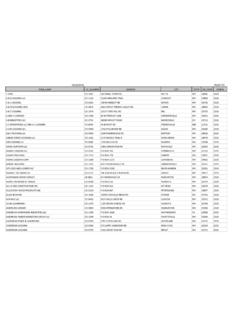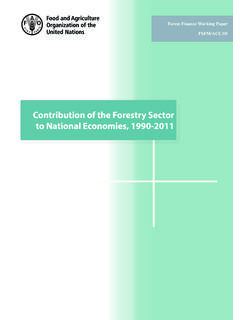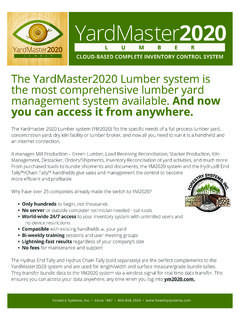Transcription of West Virginia Trees
1 west Virginia TreesBasic Tree Identification ForFFA forestry Contest Developed in cooperation with the west Virginia Division of forestry and the Tyler County FFA of Trees base upon leaves, buds, bark, and arrangement for: Aspen Leaves are 1 1/2 to 3 in diameter. Margins are toothed. Leaf stem is flatten and is attached at a 90 degree angle to the leaf blade. Aspen Bark is smooth, greenish white to cream-colored, often roughened by numerous wartlike (diamond shaped) excrescence's. White Ash Leaves are compound, 8 to 12 long and 3 to 5 wide. With 5 to 9 leaflets (mostly 7 and rarely 11 or 13). Margins are entire. Branching is opposite. White Ash Bark is ashy gray, furrowed into close diamond-shaped areas separated by narrow interlacing ridges.
2 On older Trees slightly scaly along the ridges. May have smooth patches on trunk which ranged from brown to white in color. Basswood Leaves are 5 to 6 long and 3 to 4 wide. Broadly egg shaped and the margins are coarsely toothed. Basswood Bark is gray to brown, breaking up into narrow ridges, and somewhat scaly on the surface. Beech Leaves are 2 1/2 to 6 long and 1 to 2 1/2 wide. Elliptical in shape and the margins are remotely toothed with sharp, incurved teeth. Beech Bark is thin, smooth, light blue-gray in color. Does not change as the tree grows older. Birch (Black or Sweet) Leaves are 3 to 4 1/2 long and 1 1/2 to 2 wide. Shape is somewhat egg shaped and the margins are sharply toothed.
3 Has a wintergreen smell to it. Notice the fruit at the bottom of the twig. Birch (Black or Sweet) On young Trees reddish brown to nearly black, with prominent horizontal lenticels; on mature Trees brownish black and breaking up into large thin irregular scaly plates. Black Cherry Leaves are 2 to 6 long and 1 and 1 1/2 wide. Lanceolate or spear-like in shape. Margins are finely toothed. Leaves and twigs have bitter smell when broken open. Black Cherry Bark on younger stems is smooth, reddish brown to black and has conspicuous, narrow, horizontal lenticels. On older trunks, the bark is small, black, platy scales with upturned edges. Black Oak Thick, nearly black on old stems, deeply furrowed vertically, and with many horizontal breaks.
4 Inner bark is bright orange or yellow Black Walnut Leaves are 12 to 24 long with 15 to 23 leaflets. Black Walnut Bark is dark brown to grayish black, divided by deep, narrow furrows into thin ridges. Cedar Leaves are 1/16 long, and scalelike. Redcedar leaves are pointed and White-cedar are rounded. Cedar Bark is thin, ashy gray to reddish brown, fibrous, forming a more or less network of connecting ridges and shallow furrows. Chestnut Oak Leaves are 4 to 8 long and 1 1/2 to 3 wide. Nearly lanceolate in shape and the margins are coarsely rounded. Chestnut Oak Bark is brown to nearly black, very deeply and coarsely furrowed. Cottonwood Leaves are 3 to 6 long, 4 to 5 wide; with the margins being rounded teeth like.
5 Petiole is flattened, and at 90 degree to the leaf blade. Cottonwood Light greenish yellow on young stems, eventually becoming ash-gray and dividing into thick, flattened or rounded ridges separated by deep fissures. Cucumbertree Leaves are 6 to 10 long, 3 to 5 wide. Broadly elliptical in shape. Margins are smoothed. Yellow green in color. Cucumbertree Bark is brown, fissured into narrow flaky ridges and are reddish in color when rubbed. Elm Leaves are 4 to 6 long and 1 to 3 wide. Elliptical in shape. Margins are coarsely doubly serrate or toothed. Leaf surfaces will have sandpaper texture when rubbed between fingers. Elm Bark is grayish to dark reddish brown, flat-topped ridges, separated by fissures.
6 Corky looking in texture. Hemlock Needles are 1/3 to 2/3 long, dark yellow green, and marked underneath with 2 white lines. When attached to the branches its tend to have a layer look. Hemlock Bark on young Trees flaky or scaly; soon with wide, flat ridges becoming heavily and deeply furrowed on old Leaves are 8 to 22 long depending upon species. Will have from 3 to 9 leaflets, but normally 5 to7. Inversely egg shaped. Mockernut Hickory Bark is firm, close, with low, rounded, interlacing ridges and shallow furrows. Shagbark Hickory Bark is gray, breaking up into long thin plates which curves away from the trunk, thus giving it a shaggy appearance.
7 Pignut Hickory Bark is closely and deeply furrowed with interlaced ridges often scaly or ragged on the surface. Black Locust Leaves are 8 to 14 long and pinnately compound with 7 to 19 alternate leaflets. Usually have spines on each side of where the leaf attached itself to the twig. Locust Bark is reddish brown to nearly black, deeply furrowed into rounded, interlacing, fibrous, superficially scaly ridges. Pitch Pine Needles are 3 to 5 long, in fascicles (bundles) of 3, yellow green, stiff, usually somewhat twisted, standing out at nearly right angle to the twig. Pitch Pine Pitch Pine Bark is dark and very scaly at first, becoming 1 to 2 thick, and smoother with brownish-yellow, flat plates separated by narrow irregular fissures.
8 Red Maple Leaves are 2 to 6 in diameter. Nearly circular in shape and usually 3-lobed (sometime 5-lobed). Margins are toothed. Red Maple Bark on young Trees is smooth and light gray, eventually breaking up into long, narrow, scaly plates separated by shallow fissures. Red Oak Leaves are 5 to 8 long and 4 to 5 wide. Margins will have 7 to 11 toothed lobes with pointed tips. Lobes are bristle-tipped. Red Oak Bark is brown to nearly black and broken up into wide, flat-topped ridges (gray in color), separated by shallow fissures. Red Pine Needles are 4 to 6 long, in fascicles of 2 s, dark yellow green, breaking off cleanly when doubled between the fingers.
9 Red Pine bark on young Trees flaky, orange-red; eventually breaking up into large, flat, reddish-brown superficially scaly plates. Scarlet Oak Leaves are 4 to 7 long and 3 to 5 wide. Margins are deeply 5-to 9-lobed and almost touching the midrib of the leaf. Lobes are bristle-tipped. Scarlet Oak Bark is dark brown to nearly black, broken up into irregular ridges separated by shallow fissures of varying width. Tree has a tendency to hold onto its dead branches along the trunk. Spruce Needles are 1/2 to 5/8 long and 4-sided. Dark yellow green in color. Needles are attached singular around the twig. Spruce Bark is 1/4 to 1/2 thick, separating into close, irregular, grayish to reddish-brown scales.
10 Inner layers are reddish brown. Sugar Maple Leaves are 3 to 5 in diameter and circular in outline. Usually palmately 5-lobed and the margins of the lobes is smoothed. Sugar Maple Bark is gray, and on older Trees deeply furrowed, with long, irregular, thick plate. Sweetgum Leaves are 6 to 7 inches in diameter and star-shaped. Fruit is 1 to 1 1/4 inch in diameter, a woody globosehead of 2-celled, beaked capsules and persisting during the winter. Sweetgum Bark is grayish brown; deeply furrowed into narrow, somewhat rounded, flaky ridges. Sycamore Leaves are 4 to 7 in diameter with 3 to 5 lobed. Margins are toothed. Sometimes the petiole will be cupped.














